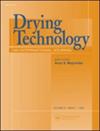污泥热干燥过程废气排放及控制技术研究进展
IF 2.7
3区 工程技术
Q3 ENGINEERING, CHEMICAL
引用次数: 0
摘要
摘要污水污泥产生量不断增加,导致有害的二次污染,凸显了污泥减量的迫切需要。污泥干燥是一种成熟的处理城市污泥的方法。本文系统综述了污泥热干燥过程中气态污染物的形成与控制的最新研究进展。首先,本文全面介绍了污水污泥干燥,包括其原理、热源以及富含有机物的污水污泥干燥过程中不可避免产生的废气。随后,总结了污水污泥干燥废气的检测方法,概述了污泥干燥废气的排放特征。所讨论的三种主要类型的干废气包括含挥发性氮化合物,以氨(NH3)为代表;挥发性含硫化合物,以硫化氢(H2S)为代表;苯系物(BTEX)。最后,基于目前的技术能力,本文提出了两种控制污泥干燥废气污染的方法:在干燥过程中抑制污染物释放和在干燥结束时处理废气。抑制干燥过程中污染物的释放主要包括通过调节污泥干燥温度和时间、采用污泥调节等方式减少污染物的释放种类和数量。干燥后端废气处理通过冷凝、吸附、吸收、生物降解等方法去除干燥废气中的污染物。本研究为了解污泥干燥过程中各种因素对干燥后废气排放特性的影响以及污泥废气排放的整体控制提供了新的视角。关键词:污泥干燥干燥废气排放特征污染控制披露声明作者未报告潜在利益冲突本研究由中央高校基本科研业务费专项资金(FRF-TP-20-010A2)和北京科技大学先进冶金技术国家重点实验室自主项目(41622202)资助。本文章由计算机程序翻译,如有差异,请以英文原文为准。
Research progress on exhaust gas emissions and control technology during sewage sludge thermal drying: A review
AbstractThe volume of sewage sludge generated continues to increase, leading to harmful secondary pollution and highlighting the pressing need for sewage sludge reduction. Sewage sludge drying is a well-established method for treating municipal sewage sludge. This study systematically reviews the latest research on the formation and control of gaseous pollutants during sewage sludge thermal drying. First, this paper comprehensively introduces sewage sludge drying, covering its principles, heat sources, and the inevitable generation of waste gas during the drying process of sewage sludge rich in organic matter. Subsequently, it summarizes the methods for detecting sewage sludge drying exhaust gas and outlines the emission characteristics of such exhaust gas. The three main types of dry exhaust gases discussed include volatile nitrogen-containing compounds, represented by ammonia (NH3); volatile sulfur-containing compounds, represented by hydrogen sulfide (H2S); and the benzene series (BTEX). Finally, based on current technical capabilities, this paper proposes two methods for controlling pollution from sewage sludge drying exhaust gas: suppressing pollutant release during the drying process and treating exhaust gas at the end of drying. Inhibition of pollutant release during the drying process primarily involves reducing the types and quantities of pollutants released by adjusting the sewage sludge drying temperature and time, employing sewage sludge conditioning, and implementing others. Drying back-end exhaust gas treatment removes contaminants from the drying exhaust gas through processes like condensation, adsorption, absorption, biodegradation and other methods. This work offers a fresh perspective on understanding how various factors in the sewage sludge drying process influence the characteristics of dried exhaust gas emissions and the overall control of sewage sludge exhaust gas emissions.Keywords: Sewage sludge dryingdry exhaust gasemission characteristicspollution control Disclosure statementNo potential conflict of interest was reported by the authors.Additional informationFundingThis research was funded by the Fundamental Research Funds for the Central Universities (FRF-TP-20-010A2) and the Self-directed Project of State Key Laboratory of Advanced Metallurgy, University of Science and Technology Beijing (41622202).
求助全文
通过发布文献求助,成功后即可免费获取论文全文。
去求助
来源期刊

Drying Technology
工程技术-工程:化工
CiteScore
7.40
自引率
15.20%
发文量
133
审稿时长
2 months
期刊介绍:
Drying Technology explores the science and technology, and the engineering aspects of drying, dewatering, and related topics.
Articles in this multi-disciplinary journal cover the following themes:
-Fundamental and applied aspects of dryers in diverse industrial sectors-
Mathematical modeling of drying and dryers-
Computer modeling of transport processes in multi-phase systems-
Material science aspects of drying-
Transport phenomena in porous media-
Design, scale-up, control and off-design analysis of dryers-
Energy, environmental, safety and techno-economic aspects-
Quality parameters in drying operations-
Pre- and post-drying operations-
Novel drying technologies.
This peer-reviewed journal provides an archival reference for scientists, engineers, and technologists in all industrial sectors and academia concerned with any aspect of thermal or nonthermal dehydration and allied operations.
 求助内容:
求助内容: 应助结果提醒方式:
应助结果提醒方式:


